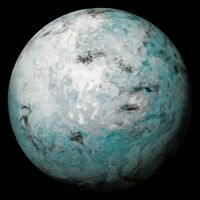Tsanfau II
 | |
| Discovery | |
|---|---|
| Discovered by | Allister Llloyd |
| Discovery date | 15 November 1799 at the
Layfet Colonial Observatory, Layfet, |
| Designations | |
| MPC designation | Tsanfau II |
| Orbital characteristics | |
| Satellite of | Tsanfau |
| Physical characteristics | |
Mean radius | 344/5 km |
| Mass | 1.911E+20 |
Mean density | 1.116 g/cm^3 |
| 0.107 m/s^2 | |
| 272.1 m/s | |
| Atmosphere | |
| Composition by volume | 78% methane (CH4), 5% ammonia (NH3), 5% water (H20) 5% ammonium hydrosulfide (NH4SH) 5% methane hydrate, 2% trace other gases |
Tsanfau II is the second-largest moon of Tsanfau. It is about 690 kilometers (428 mi) in diameter. Tsanfau II is mostly covered by freshly created and relatively clean ice sheets, exposed rocky mountaintops, old craters, ice scraps, ice geysers, water-ice layers, and a surprisingly dense atmosphere for its size.
Tsanfau II was discovered on November 15, 1799, by astronomer Allister Llyod, but little was known about the moon until much later. Flybys by space probes revealed its surface, atmosphere, and environment in greater detail. The most surprising of discoveries being the relatively dense atmosphere and ice geysers that produced jets of materials and chemicals. These ice geysers are leading contender into why Tsanfau II has such a dense atmosphere for its size and proximity to Tsanfau. The planet itself is constantly tugging on Tsanfau II's atmosphere, which may be a factor in Tsanfau II's weather patterns. Tsanfau II is also currently geologically active and may have a subsurface ocean.